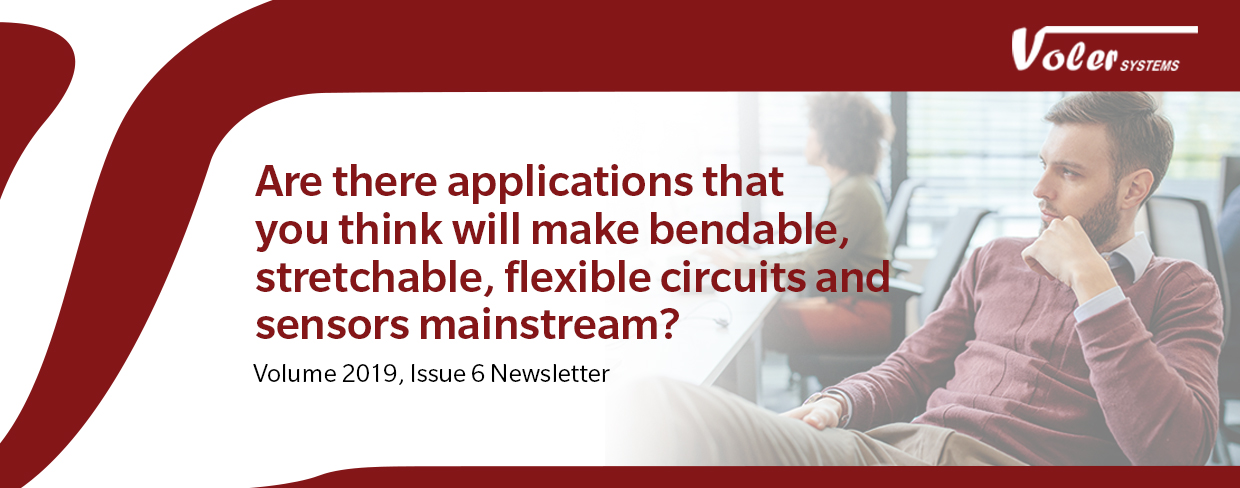Thanks for your advice and feedback on my email last month. Below is a summary of what I heard:
Are there applications that you think will make bendable, stretchable, flexible circuits and sensors mainstream?
We heard a wide range of applications where bendable, stretchable, flexible circuits were needed. The applications we heard included
- surgical robotics
- medical including wound closure and monitoring for infection
- smart garments
- phones
- gaming and controllers
Rajesh Kanungo from talasecure reminded me that some areas where bendable circuits are important are:
- Systems where impact can cause deformation. This is in the area of active monitoring of construction, factory machinery.
- Circuits that have to unfold inside, say a person’s stomach,
- Replacement sensors and circuits can be folded and placed (after folding the bad part and pulling it out. You save a lot by not having to disassemble a whole transmission or an engine block.
Tom Shoup reminded me that flex circuits are already mainstream and have been for 40 years or more. Every ultrasound transducer with more than one element (phased arrays, linear arrays) usually has two flex circuits in it, used to connect the cable to the array elements. The flex circuits used to be epoxy bonded to the piezoelectric element but that changed for at least one manufacturer 30 years ago. You can tell he likes flex circuits!
Phil Cannon from cartsys had a number of great use cases but my favorite was “a find your phone ” type of sensor that would be sewn into clothing that would let you find your coat, etc.
Doug Gibbs cautioned us that the reliability has to be orders of magnitude better. 100K flexes sounds like a lot, but is maybe six months of usable life.
Do you know that for most wireless products we help develop, the hiring company rarely asks about security issues, and we have to bring them up. Why is that?
Most people were not surprised. In the best case, it might be an unknown-unknown – individuals don’t even know to ask the question. Many do think and plan for security in their products.
What technologies do you anticipate will be important to new product capabilities you plan to develop or offer in 2019 / 2020?
We heard about some exciting technologies including
- Motion detection in a haptic system
- Optical marker sensing
- IoT applications, Industrial IOT (IIoT), and remote medical applications
- Extensive area monitoring (e.g. hospitals, stadiums, shopping malls)
- Liquid biopsy
- In vitro diagnostics (IVD)
- 3D metal printing
- High temperature electronics
Edge computing
- High-speed switching
- Cloud analytics
- Neural networks
- Machine learning
Power
- smaller and denser batteries
- more power efficient radios
- higher density energy storage
- lower power memory
Do you see any of the emerging narrow band communication wireless standards getting real traction?
Most people we asked did not know much about these technologies. However, those who are in this space, like Amazon and companies with parking, building and industrial control products had some very interesting feedback.
They thought LoRa and LTE CAT-M are absolutely getting traction. CAT-M is being pushed by cellular carriers and getting into many IoT devices. LoRa is mainly being driven by industry despite the promise of carrier-supported LoRa networks that would cover the US (carrier-grade LoRa networks already exist in Europe). LoRa gateways are becoming mainstream but still have limited functionality because most do not support the LoRaWAN application layer, only the LoRa phy. I do know of several companies (including Amazon) with real projects built on LoRa, so I think we are past the hobby stage. We did hear some concern about pricing models and bandwidth constraints.
Thank you very much for your help. I truly value my network of peers. It is a very insightful group! – Walt
